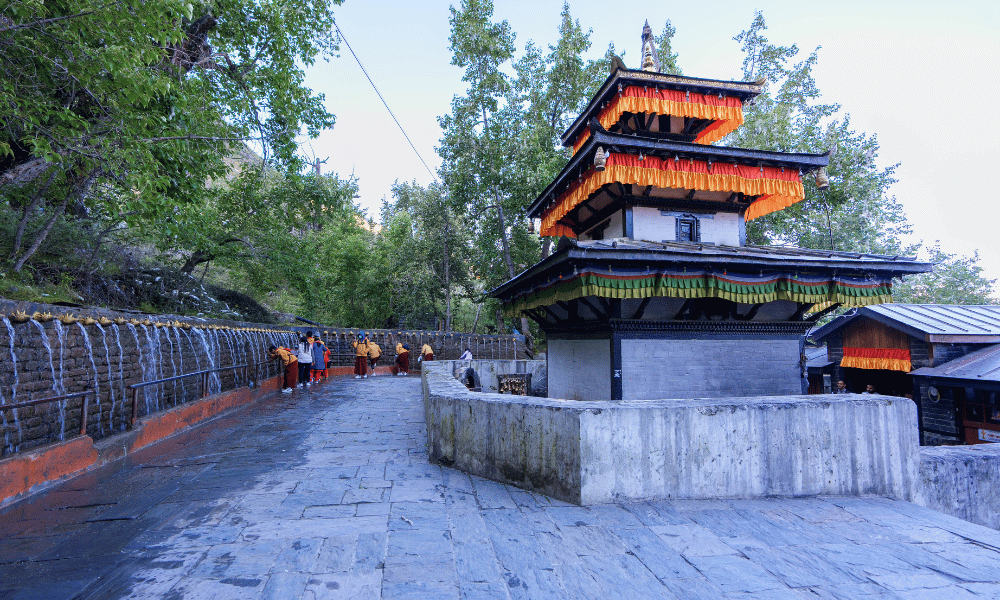Muktinath Temple, nestled amidst the stunning landscapes of the Annapurna mountain range in Nepal, stands as a testimony to the country's rich cultural tapestry and natural beauty. Embarking on a journey to this sacred temple not only promises a spiritual experience but also a glimpse into its rich history and the confluence of two major religions, Hinduism and Buddhism.
Historical Significance of Muktinath Temple
Muktinath Temple has been around for a long time. Its history goes back hundreds of years. It is mentioned in old Hindu texts like the Puranas, Mahabharata, and Barah Purana, which shows how important it is to the Hindu religion. The name "Muktinath'' comes from two words: "Mukti," which means "salvation," and "Nath," which means "lord" or "master." Hindu legend claims that Lord Vishnu appeared at this spot, which is why it is a highly symbolic Vishnu temple.
Over the years, the temple has been fixed up and put back together many times. Even with all the changes, it has remained a major pilgrimage spot that people from all over India and Nepal come to visit. Its historical importance also comes from the fact that it was a place where Hindu and Buddhist cultures combined.
Religious Importance (Both Hindu and Buddhist)
Both Hindus and Buddhists look up to the Muktinath Temple as a shining example of religious harmony. Hindus are proud of it because it is one of the 108 Divya Desam, which are the holiest shrines to Lord Vishnu. People believe that going on a pilgrimage to this temple will help them reach Moksha, which means getting out of the cycle of rebirth. A lot of people go to the temple to worship Lord Vishnu, who is considered the protector of the universe.
On the other hand, Buddhists regard this place as a sacred site associated with Guru Rinpoche, also known as Padmasambhava, who is thought highly of for spreading Buddhism in Tibet in the 8th century. The temple complex has a Buddhist monastery, where the eternal flame that burns from natural gas sources has been the center of Buddhist rituals and worship.
The temple grounds have both Hindu and Buddhist shrines and works of art. This shows the perfect combination of cultures and beliefs and encourages religious unity and tolerance.
Geographical Location
The Muktinath Temple is located at an altitude of 3,710 meters at the foot of the Thorong La mountain pass in the Mustang district of Nepal. It's situated up and far away, surrounded by the beautiful Annapurna and Dhaulagiri mountain ranges. This gives it a peaceful and spiritual atmosphere that attracts both monks and tourists.
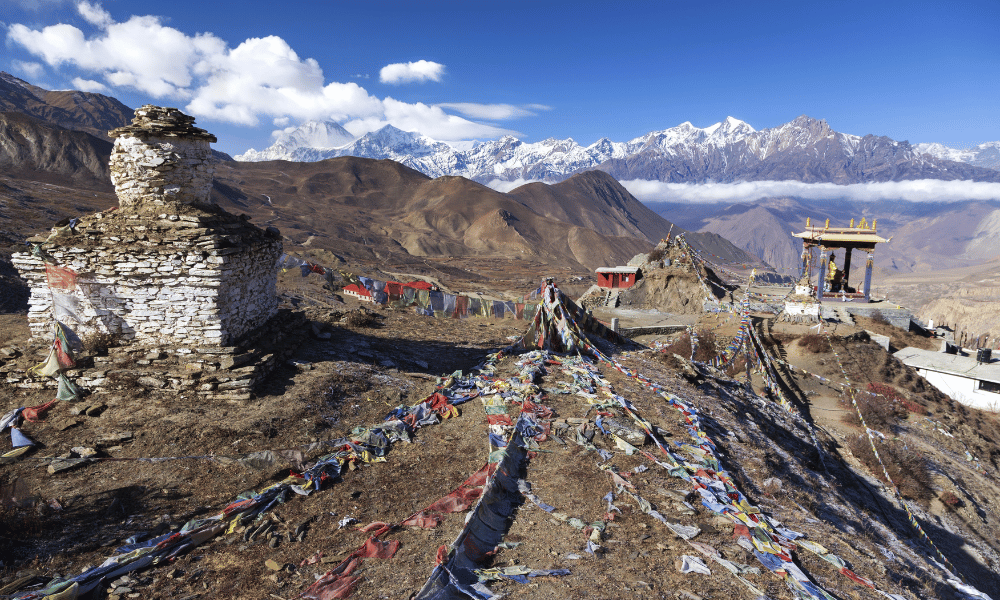
To get to the temple, you have to take a trip that combines driving and hiking, passing through beautiful landscapes, lush valleys, and lovely towns. People believe that the trip itself is a spiritual cleansing process that prepares devotees to reach the holy land of Muktinath.
To get to the temple, you have to go to Pokhara, a famous tourist city in Nepal, and then fly or drive to Jomsom. From Jomsom, worshippers can trek or take a jeep to the temple. Due to its location in the mountains, the trip to Muktinath is a mix of spirituality and adventure, with beautiful views to enjoy along the way.
Importance of the Visit
A pilgrimage to the Muktinath Temple is not merely a journey; it's an experience that encompasses profound spirituality, breathtaking scenic beauty, and a rich cultural immersion. Let's delve deeper into what makes a visit to Muktinath an unforgettable experience:

Spiritual Significance
Divine Connection:
The Muktinath Temple is revered as a place of salvation where devotees come to seek moksha, or liberation from the cycle of rebirth. The temple is said to be a potent place to cleanse one's soul, with many pilgrims taking a dip in the sacred waters of the 108 Mukti Dhara, believing it to purge them of their sins.
Vibrant Energy:
The region vibrates with a unique spiritual energy, accentuated by the sounds of ringing bells, prayer chants, and the natural harmony of the surrounding mountains. Many pilgrims and tourists alike report a sense of peace and tranquillity enveloping them as they step into the temple precincts, making it a profound spiritual journey.
Scenic Beauty
Natural Grandeur:
The Muktinath Temple is ensconced amidst the towering peaks of the Himalayas, offering breathtaking views of the Annapurna and Dhaulagiri ranges. The journey towards the temple unfurls a canvas of nature's finest artwork, with lush valleys, terraced fields, and flowering rhododendrons painting a picturesque backdrop.
Stunning Sunrise and Sunsets:
The area offers spellbinding views of sunrise and sunset, with the golden rays of the sun casting an ethereal glow on the snow-capped mountains. The beauty of nature, in its raw and untouched form, serves as a testimony to the divine power that many come to experience at Muktinath.
Cultural Immersion
Fusion of Religions:
A visit to Muktinath is a cultural eye-opener, showcasing a harmonious blend of Hindu and Buddhist philosophies co-existing in one sacred space. This fusion is evident in the architectural designs, rituals, and festivals celebrated here.
Rich Traditions:
The temple vicinity is a hub of rich traditions and customs. The local communities, mainly the Thakali, Gurung, and Magar tribes, have a rich cultural heritage, offering a chance for visitors to immerse themselves in traditional Nepalese lifestyle, culinary experiences, and folklore.
Festivals and Rituals:
Visitors to Muktinath can also witness and participate in various festivals and rituals that take place throughout the year. These events offer a profound insight into the local culture, with vibrant displays of traditional music, dance, and costumes.
Kathmandu to Muktinath
The trip to Muktinath, situated in the high Himalayas, is full of beautiful views and various landscapes. Here are the ways to get from Kathmandu to Muktinath for those who want to set out on this journey or adventure:
Flight via Pokhara/Jomsom
Kathmandu to Pokhara: Your journey begins with a flight from Kathmandu to Pokhara, which takes about 25-30 minutes. The flight offers stunning aerial views of the Nepalese countryside and the towering mountain ranges.
Also read: Best Time To Visit Kathmandu And Pokhara
Pokhara to Jomsom: After a brief stopover in Pokhara, the next leg of your journey is a flight to Jomsom. This short flight, lasting approximately 20-25 minutes, takes you closer to the mountains, offering breathtaking vistas that are a prelude to the scenic beauty awaiting you at Muktinath.
Public Bus
For budget-conscious travelers, the public bus is a viable option.
Kathmandu to Jomsom: From Kathmandu (New Bus Park) on a daily basis, the bus goes from Kathmandu to Jomsom via Pokhara. On the ground, it's about 360 kilometers from Kathmandu to Jomsom. It takes about 15–18 hours to reach Jomsom, and you'll see a lot of the authentic Nepalese scenery along the way.
Private Vehicle
Hiring a private vehicle is an excellent choice for those looking for comfort and flexibility.
Kathmandu to Pokhara: You can rent a private vehicle to drive from Kathmandu to Pokhara, a journey that allows you to explore the picturesque surroundings at your own pace.
Pokhara to Jomsom: Similarly, from Pokhara, you can continue your journey in a private vehicle to Jomsom, taking stops en route to appreciate the natural beauty and perhaps explore lesser-known spots.
Chartered Helicopter
For those looking to reach Muktinath in the quickest and most comfortable manner, a chartered helicopter is the best option.
Kathmandu to Muktinath Direct: You can charter a helicopter directly from Kathmandu to Muktinath. This option, while being the most expensive, offers a once-in-a-lifetime experience, providing aerial views of the majestic Himalayan ranges and reducing the travel time considerably.
Related Read: Muktinath Helicopter Tour
Pokhara to Muktinath
After you reach Pokhara, the real adventure begins with the trip to Muktinath, which takes you through the most beautiful areas of Nepal. Here are the different ways you can get to the sacred temple from Pokhara:
Flight via Jomsom
Fast and Scenic: The quickest way to travel from Pokhara to Muktinath is by taking a flight to Jomsom. This short flight takes approximately 20-25 minutes, soaring over the stunning Annapurna and Dhaulagiri mountain ranges.
Jomsom to Muktinath: After landing in Jomsom, you would need to hire a jeep or trek to Muktinath, which is about 21-24 km away. The trek can be a spiritually enriching experience, bringing you closer to nature.
Public Bus
Economical and Authentic: For travelers on a budget, the public bus is a good option. The trip from Pokhara to Jomsom is about 160 kilometers long and takes about 10 to 12 hours. The route offers an authentic glimpse into the rural life of Nepal.
Local Connectivity: From Jomsom, local buses or shared jeeps are available to take you to Muktinath, providing an opportunity to mingle with locals and understand their way of life.
Private Vehicle
Comfortable and Flexible: Renting a private vehicle from Pokhara to Muktinath offers a comfortable and personalized experience. You can stop at various points to enjoy the scenic vistas and explore the local culture.
Off-road Adventure: The road from Jomsom to Muktinath is a rugged trail, promising an adventurous ride amidst the mountains. A private vehicle allows you to enjoy this journey at your own pace.
Chartered Helicopter
Luxurious and Quick: For those seeking a luxurious and fast mode of transport, chartering a helicopter from Pokhara to Muktinath is the best choice. This option not only cuts down the travel time but also offers an unparalleled aerial view of the majestic Himalayan landscapes.
Direct Access: The helicopter can land close to the temple, making it a convenient option for those who wish to avoid the long trek from Jomsom to Muktinath.
Jomsom to Muktinath
As you reach Jomsom, the gateway to Muktinath, you'll have a couple of choices about how to complete the final phase of your journey. Getting to Muktinath, whether on foot or in a vehicle, is a beautiful experience. Here is what you can expect:
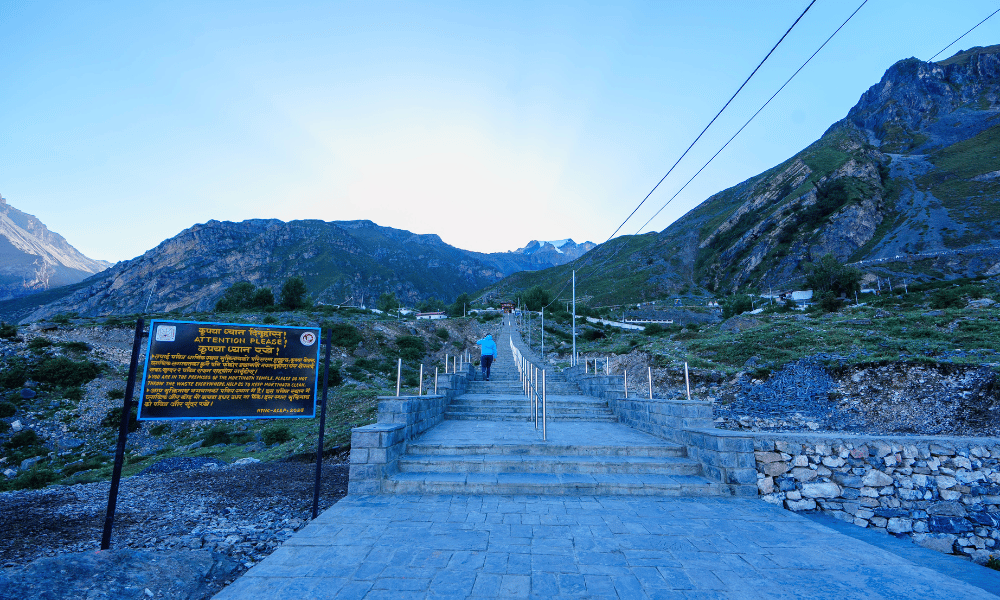
Trekking
The Pilgrim’s Trail:
- Duration: Approximately 6-8 hours.
- Route: Follow the ancient pilgrim trail, which meanders through quaint villages and lush apple orchards.
- Experience: As you trek, you'll be enveloped in tranquility, with the rhythms of nature accompanying your steps. The trail is moderately challenging, offering an enriching experience for both novice and seasoned trekkers.
- Tips: Ensure to carry water, snacks, and a good pair of hiking boots. Acclimatize well to avoid altitude sickness and start early to avoid the afternoon winds.
Exploration Opportunities:
- Dhumba Lake: A detour to this stunning lake adds a splash of color to your journey.
- Jhong: This beautiful village offers a glimpse of local life, with its traditional houses and monasteries.
Jeep/Bus
The Motor Road:
- Duration: Approximately 1.5-2 hours.
- Route: The road from Jomsom to Muktinath is a rugged trail that navigates through rocky terrains and beautiful landscapes.
- Experience: A jeep or bus ride offers a comfortable and faster alternative to trekking. As you travel, enjoy the panoramic views of the snow-clad mountains and the Kali Gandaki River valley.
- Tips: Book your seat in advance, especially during the peak pilgrimage season. Keep your camera ready to capture the stunning vistas.
Sightseeing En Route:
- Kagbeni: This medieval village is a popular stopover, known for its beautiful alleys and a monastery that dates back to the 15th century.
- Muktinath Valley: Before reaching the temple, you’ll pass through the Muktinath Valley, which offers breathtaking views and opportunities to witness local life and culture.
Useful Read: Nepal Trekking Gear Checklist
Permits and Documentation
Before you start your trip to Muktinath, you need to make sure you have all the appropriate permits and paperwork. Here, we explain the different kinds of permits you might need and how to get them:
TIMS (Trekkers' Information Management System) Card
- Purpose: The TIMS card is a necessary permit that helps the government to keep track of trekkers for safety and security reasons, and to maintain the trekking routes.
- Where to Obtain: You can get the TIMS card from government licensed trekking agencies.
- Documents Required: Two passport-sized photos and a copy of your passport.
- Cost: The fee for the card is NRP 2000 pp.
Note: Be sure to carry your TIMS card with you at all times as you may need to show it at various checkpoints.
ACAP (Annapurna Conservation Area Permit)
- Purpose: This permit is necessary for conservation and management of the natural and cultural resources of the Annapurna region.
- Where to Obtain: Like the TIMS card, the ACAP can be obtained at the Tourism Board Office in Kathmandu or Pokhara.
- Documents Required: You will need to provide two passport-sized photos along with a copy of your passport.
- Cost: The cost of the permit is determined based on the nationality of the trekker. (NRP 1000 for Indian nationals)
Other Necessary Permits (if any)
- Local Permits: Depending upon your exact trekking route, you might need to obtain additional local area permits, which can be obtained at local government offices or checkpoints along the trail.
- Restricted Area Permits: If you plan to explore areas that are considered restricted, you will need to acquire a special permit. The requirements and fees for these permits can vary, so it's best to check with the local government or a reliable trekking agency for the most current information.
Useful read: Restricted Areas In Nepal
Tips for Travelers
- Photocopies and Photos: Carry several copies of your passport and extra passport-sized photos, as you might need them for various permits.
- Verified Trekking Agencies: If you are planning your trip through a trekking agency, they can often help arrange for all necessary permits, saving you time and hassle.
- Time Frame: Start the permit process well in advance to avoid any delays in your travel plans.
Also Read: Muktinath Tour Package From India
Accommodation Options in Jomsom
Finding a comfortable place to rest is an important part of any trip. As a popular stopover on the way to Muktinath, Jomsom has a range of places to stay to meet various preferences and budgets. Here, we talk about some of the choices:
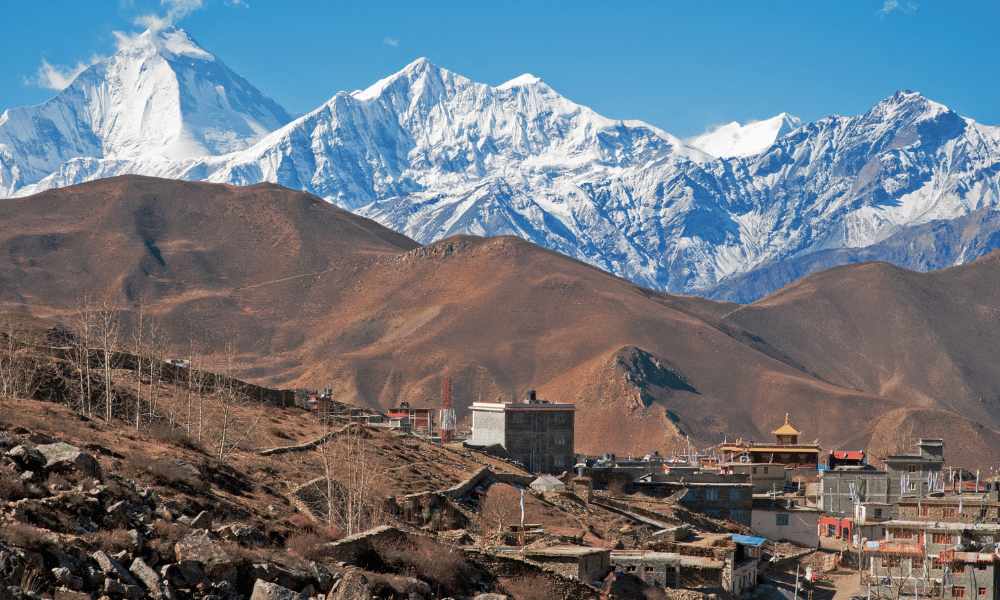
Guesthouses
Homely and Affordable:
- Ambiance: Guesthouses in Jomsom usually offer a warm and home-like atmosphere. Many are family-run establishments, where you can experience the local culture and hospitality up close.
- Facilities: These accommodations often provide basic facilities such as comfortable beds, hot water, and home-cooked meals.
- Cost: Being budget-friendly, they are an excellent option for backpackers and budget travelers.
- Booking: While some guesthouses allow walk-in bookings, it is advisable to book in advance, especially during the peak season.
- Recommended Guesthouses: (Include a list of popular guesthouses along with brief descriptions and contact details).
Lodges
Comfort and Convenience:
- Ambiance: Lodges in Jomsom offer a blend of comfort and modern amenities. These establishments are usually larger than guesthouses and offer a range of room options.
- Facilities: Expect amenities like well-furnished rooms, en-suite bathrooms, and in-house restaurants serving a variety of cuisines. Some lodges may also offer WiFi, heated rooms, and other facilities for a comfortable stay.
- Cost: Generally, lodges are priced moderately, offering a good balance between comfort and cost.
- Booking: Many lodges allow online bookings through their websites or popular travel platforms.
- Recommended Lodges: (Include a list of popular lodges with brief descriptions and contact details).
Tips for Travelers:
- Early Booking: Due to the high influx of pilgrims and tourists during the peak season, it's advisable to book your accommodation well in advance.
- Reviews and Ratings: Before booking, check reviews and ratings to get an insight into the quality of service and facilities offered.
- Local Cuisine: Try staying in accommodations that offer local cuisines as part of their menu to enjoy an authentic culinary experience.
- Sustainability: Consider staying in accommodations that practice sustainable tourism by implementing environmentally friendly practices.
Useful Read: Travel Information For Indians Visiting Nepal | Nepal Travel Information
Accommodation Options In Muktinath
Since Muktinath is a holy pilgrimage spot, it draws a lot of visitors every year. Even though the area is out in the middle of nowhere, it has a variety of places to stay to fit different tastes. Here's a full rundown of what you can do:
Basic Guesthouses
Simplicity and Serenity:
- Ambiance: These guesthouses often portray simplicity and a peaceful environment, allowing you to connect with the tranquil surroundings of Muktinath.
- Facilities: While basic, these guest houses provide essential amenities such as clean beds, warm blankets, and shared bathroom facilities.
- Cost: Being quite affordable, they attract backpackers and budget travelers looking for a no-frills accommodation option.
- Booking: Given the limited number of rooms, it might be best to book your stay in advance, particularly during the peak season.
- Recommended Guesthouses: (Include a list of popular guesthouses along with brief descriptions and contact details).
Lodges
Comfort Amidst the Mountains:
- Ambiance: The lodges in Muktinath offer a bit more comfort compared to the basic guesthouses. They are set against the backdrop of the majestic mountains, offering scenic views right from your window.
- Facilities: These lodges generally offer amenities such as comfortable beds, private bathrooms, and dining facilities where you can enjoy a variety of cuisines.
- Cost: The lodges are moderately priced, offering a good balance of comfort and value for money.
- Booking: Most lodges allow bookings through phone or online platforms, securing your accommodation before your arrival.
- Recommended Lodges: (Include a list of popular lodges with brief descriptions and contact details).
Traveler Tips:
- Cultural Sensitivity: While staying in Muktinath, respect the local customs and traditions, as the area is of great religious significance.
- Packing Essentials: Due to the chilly weather, especially during the evenings, carry warm clothing even during the summer months.
- Local Interaction: Opt for accommodations that provide opportunities for interacting with the locals, offering a deeper insight into their way of life.
- Electricity and Connectivity: Be prepared for intermittent electricity and network connectivity. Carry power banks and other necessary gadgets.
Best Time to Visit
A visit to Muktinath can be a profoundly enriching experience, and choosing the right time to visit can enhance it manifold. Let's explore the ideal periods to visit based on weather conditions and the vibrant festivals that the region hosts:
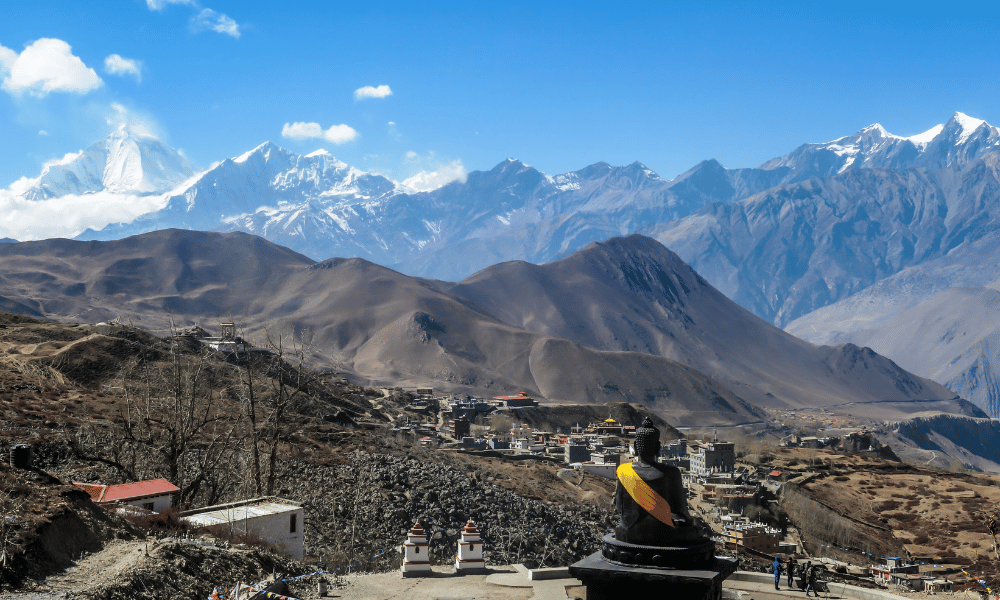
Spring (March to May)
-
Description: Spring is one of the most popular times to visit Muktinath. The weather is pleasant, with clear skies offering breathtaking views of the surrounding mountains.
-
Recommendation: Ideal for trekking and outdoor activities.
Summer (June to August)
-
Description: This period marks the monsoon season, characterized by frequent rains and cloudy skies.
-
Recommendation: Though not the best time for trekking, the rains bring a fresh burst of greenery, making the landscapes picturesque.
Autumn (September to November)
-
Description: Autumn is another preferred time to visit, with stable weather and minimal rainfall. The clear skies offer an excellent opportunity for photography.
-
Recommendation: A favored time for pilgrimage and trekking.
Winter (December to February)
-
Description: The region experiences cold temperatures and snowfall during this period. Many trails might be closed due to snow.
-
Recommendation: Suitable for those looking to experience the winter landscapes, but be prepared for chilly conditions and limited accessibility.
In Depth Read: Best Time to Visit Muktinath Temple
Festivals and Special Events
Muktinath Yatra (September)
-
Description: A significant event where pilgrims flock to the temple to offer prayers and participate in religious ceremonies.
-
Recommendation: A great time to immerse yourself in the rich cultural and spiritual heritage of the region.
Vishu Festival (April)
-
Description: This festival marks the Hindu new year and is celebrated with great fervor.
-
Recommendation: Experience the local customs and rituals during this vibrant festival.
Yartung Festival (August)
-
Description: This is a traditional festival celebrated in the lower Mustang region, including Muktinath. It includes horse racing and other cultural events.
-
Recommendation: A fascinating time to witness the blend of culture and tradition in the festivities.
Useful Read: 10 Popular Himalayan festivals in Nepal | Nepal Festival
Packing Tips
A trip to Muktinath is a blend of spiritual enrichment and adventure. Packing appropriately can help you enjoy a comfortable journey while respecting the local customs and traditions. Here's a guide to help you pack:
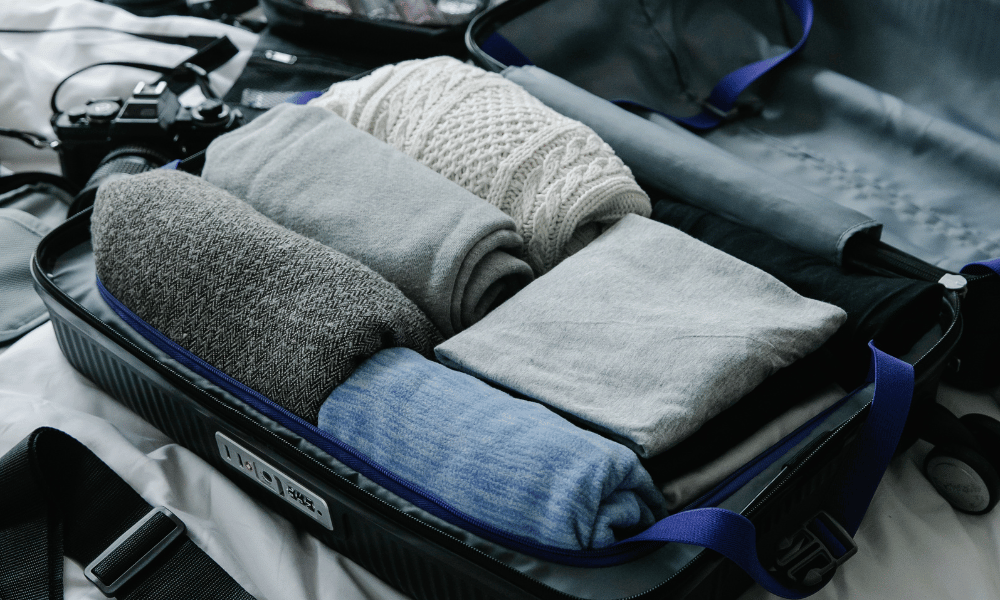
Clothing
- Layered Clothing: Given the fluctuating temperatures, it’s recommended to carry clothing that can be layered. Include lightweight garments for daytime and warm clothing for the colder evenings.
- Waterproof Gear: If you plan to visit during the monsoon season, don’t forget to pack waterproof jackets and trousers.
- Footwear: Comfortable walking or trekking shoes are a must for the rugged terrains.
Personal Essentials
- Sun Protection: Carry sunscreen, sunglasses, and hats to protect yourself from the high-altitude sun.
- Hygiene Products: Include hand sanitizers, wet wipes, and personal hygiene products in your packing list.
- Medication: Apart from your regular medication, it's wise to carry a basic first-aid kit with essentials like pain relievers, band-aids, and oral rehydration salts.
Altitude Sickness Preventions
- Acclimatization: Allow time in your itinerary for acclimatization to prevent altitude sickness.
- Hydration: Keep yourself hydrated throughout the journey. Carry reusable water bottles to refill.
- Medications: Consult with your doctor before the trip and carry prescribed medications to prevent altitude sickness.
Cultural Sensitivity Tips
Appropriate Attire
- Temple Visit: Dress modestly while visiting the temple. It is recommended to cover your shoulders and knees as a sign of respect.
- Interaction with Locals: When interacting with the locals, wearing non-revealing clothing is appreciated.
Behavior in the Temple
- Photography: Ask for permission before taking photos inside the temple premises.
- Shoes: Remove your shoes before entering the main temple area.
- Prayers and Offerings: Participate or observe the rituals respectfully. It's best to follow the lead of the locals or guides when it comes to participating in religious activities.
Additional Tips:
- Light Backpack: Carry a light backpack for daily excursions, including essentials like water bottles, snacks, and a camera.
- Local Etiquette: Learn a few local phrases and greetings to connect better with the local community.
- Guides and Porters: If your itinerary includes trekking, consider hiring local guides and porters who are experienced with the terrain and can offer valuable insights during the journey.
Before You Go
To ensure a fulfilling and respectful visit to the sacred site of Muktinath, it’s essential to familiarize yourself with the local rituals and customs. Additionally, considering the services of local guides can significantly enhance your experience. Here's what you need to know before setting off on your journey:
Rituals and Customs
Understanding and respecting the local rituals and customs can provide a deeper connection to the place and its people. Here are a few aspects to be aware of:
- Sacred Sites: Learn about the significance of the various sacred sites within the Muktinath Temple complex. This will enrich your visit and help you appreciate the spiritual depth of the place.
- Offerings and Prayers: Be aware of the proper ways to make offerings or participate in prayers at the temple. Usually, offerings include fruits, flowers, or monetary donations.
- Local Festivals: If your visit coincides with a local festival, learn about the customs and practices associated with the festival to enjoy a richer experience.
- Community Interaction: Understand the norms of interacting with the local community. A respectful and friendly approach can open doors to heartwarming interactions.
Local Guides
Hiring a local guide can offer several benefits:
- Insightful Narratives: Local guides bring a wealth of knowledge and personal anecdotes that can bring the history and culture of Muktinath to life.
- Language Assistance: A local guide can assist with language barriers, facilitating smoother interactions with the local community.
- Customized Itinerary: Local guides can help tailor your itinerary to include lesser-known spots and experiences, offering a unique perspective on the region.
- Safety and Comfort: In the rugged terrains of Muktinath, having a local guide can ensure safety and provide assistance in case of emergencies.
Things to Remember:
- Pre-booking Guides: Consider pre-booking your guide to ensure availability, especially during peak seasons.
- Guide Credentials: Ensure to hire guides with official credentials or those recommended by reputable agencies.
- Tip Generously: Guides often depend on tips for their livelihood. If you’re happy with their service, consider tipping generously.
Temple Complex
The Muktinath Temple Complex stands as a testimony to the rich cultural, religious, and historical significance of the region. Set against the backdrop of the magnificent Himalayas, the complex invites visitors to embark on a spiritual and aesthetic journey. Here’s a guided walk through the major attractions within the complex:
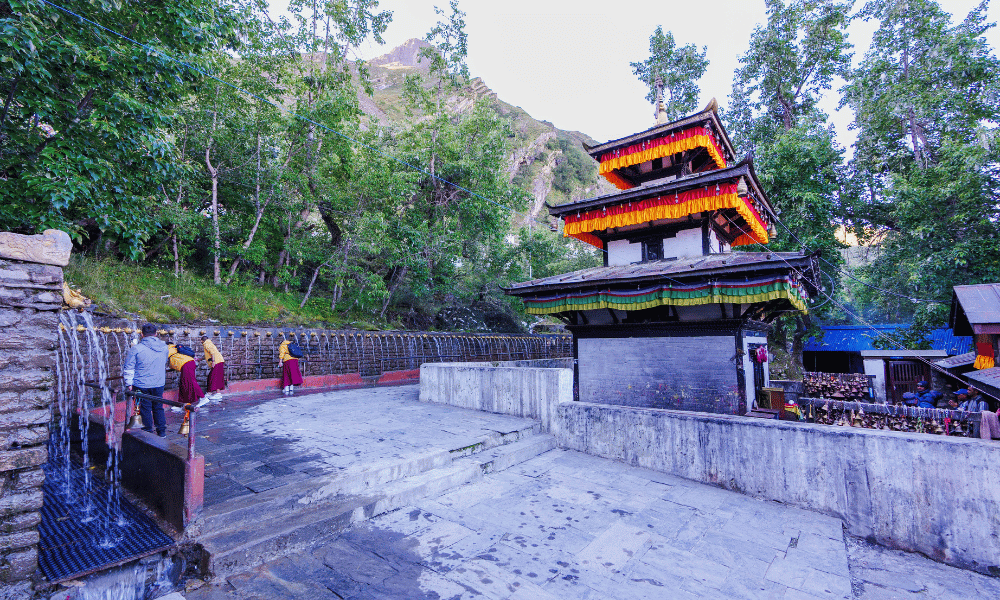
Description of the Temple Complex
- Architectural Brilliance: The temple complex showcases a blend of Hindu and Buddhist architectural elements. As you step in, you'll notice the intricately carved wooden structures and metal works that adorn the buildings.
- Natural Setting: Nestled amidst the mountains, the complex offers breathtaking views, creating a serene and peaceful atmosphere that complements the spiritual essence of the place.
Major Attractions within the Complex
Muktinath Temple Itself
- Sanctity: Considered as one of the 108 Divya Desam, the temple is a significant pilgrimage site for Hindus as well as Buddhists.
- Deity: The central deity of the temple is Lord Vishnu, revered as the Lord of Salvation.
- Architecture: The temple features a pagoda-style structure, reflecting the rich cultural amalgamation of the region.
- Visiting Tips: While here, take time to meditate or offer prayers for a spiritually uplifting experience.
Jwala Mai Temple
- Location: Situated to the south of Muktinath Temple, it is a revered site housing an eternal flame.
- The Eternal Flame: The temple houses a continuously burning holy flame, which emanates from a rock, a phenomenon attributed to natural gas sources.
- Significance: The flame is considered sacred, representing the fire god Agni, and is a central part of various rituals and pujas conducted here.
- Visiting Tips: Witness the unique rituals performed by devotees, offering a glimpse into the deep-rooted religious practices.
Mukti Dhara
- Location: Found in the courtyard of the Muktinath Temple, it is a prominent site for pilgrims.
- Spiritual Significance: Devotees believe that bathing in the waters of Mukti Dhara can cleanse them of their sins and lead to salvation.
- Physical Setup: The area consists of 108 water spouts arranged in the shape of a cow's head, which is considered sacred in Hinduism.
- Visiting Tips: If you plan to partake in the ritualistic bath, come prepared with appropriate clothing.
108 Mukti Dhara
- Connection with Mukti Dhara: This refers to the 108 water spouts that are part of the Mukti Dhara, emphasizing the significance of the number 108 in Hinduism and Buddhism.
- Rituals: Pilgrims visiting the temple make it a point to take a bath under each of these 108 spouts as a part of their pilgrimage rituals.
- Symbolism: The 108 spouts symbolize the 108 beads in a Hindu prayer mala (rosary), which is used for meditation and prayers.
- Visiting Tips: While participating, maintain a serene and respectful demeanor to honor the spiritual significance of the ritual.
Related Article: Muktinath Temple Photos
Surrounding Attractions
Once you've absorbed the spiritual richness of Muktinath Temple Complex, step out to explore the vibrant life and natural beauty that surround it. From picturesque villages to thrilling treks, the region has something for every kind of traveler. Here's a guide to help you discover the treasures that await:
Villages to Explore
Kagbeni:
- Description: A gateway to the Upper Mustang, this village offers a glimpse into the traditional life of the region with its ancient monasteries and mud-brick houses.
- Attractions: Kagbeni Monastery, Ancient Royal Palace.
- Cultural Experience: Witness the daily life of the locals, engage in conversations, and enjoy the local cuisine.
Jharkot:
- Description: A rustic village that offers a peek into the rich cultural and architectural heritage of the region.
- Attractions: Jharkot Monastery, Ancient Fort.
- Cultural Experience: Participate in local festivals and observe the unique customs of the region.
Natural Sights
Dhumba Lake:
- Description: A stunning high-altitude freshwater lake nestled amidst the mountains.
- Activities: Photography, Picnicking.
- Best Time to Visit: Early morning or late afternoon for the best views and photographs.
Rupse Waterfall:
- Description: A majestic waterfall cascading down the rugged mountain terrains.
- Activities: Hiking, Photography.
- Best Time to Visit: The post-monsoon season when the waterfall is in its full glory.
Conclusion
As we reach the end of this detailed guide, let's take a moment to reflect about the unique and varied journey you'll have at Muktinath. A pilgrimage to this holy site is more than just a spiritual experience; it's also an opportunity to learn about the region's rich culture, history, and stunning natural beauty.
Recap of the Significance of the Visit
- Spiritual Enlightenment: Your visit to the Muktinath Temple Complex promises a spiritual awakening, where you can connect with the divine amidst the tranquility of the mountains.
- Cultural Immersion: The neighboring villages offer a deep dive into the local culture, presenting a wonderful chance to interact with the warm and welcoming locals, and learn about their customs and traditions.
- Natural Beauty: With its pristine lakes and cascading waterfalls, the region promises scenic vistas that can soothe your soul and offer photographic memories that last a lifetime.
Personal Tips and Recommendations
-
Local Cuisine: Don't miss out on trying the local Nepalese dishes. Whether it's a warm plate of Dal Bhat or some traditional Newari cuisine, your taste buds are in for a treat.
-
Photography: Carry a good camera to capture the stunning landscapes and the intricate details of the temple architecture.
-
Community Engagement: Consider taking some time to volunteer in the local communities. It not only helps in building bonds but also gives a deeper insight into the local way of life.
-
Souvenirs: Bring back a piece of Muktinath with you by purchasing local handicrafts and products, which also supports the local economy.
-
Mindful Travel: As you explore this sacred site, remember to travel responsibly. Respect the local customs and the environment, ensuring that it remains pristine for generations to come.
For Best Packages: Muktinath Tour Packages

